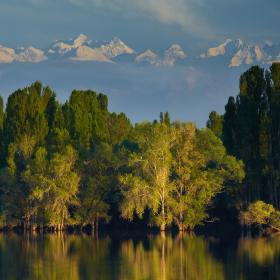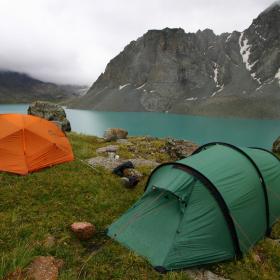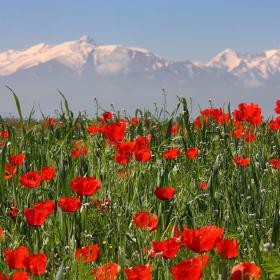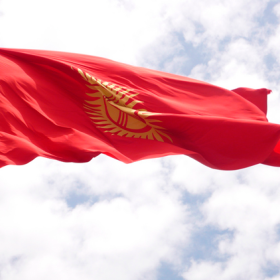National parks and reserves
Protected Objects of Nature help to preserve the unique natural landscapes of Kyrgyzstan in their original form. In order to save wonderful natural landscapes, flora and fauna of the country there were created 6 reserves, 2 biosphere reserves protected by UNESCO and 75 national parks.
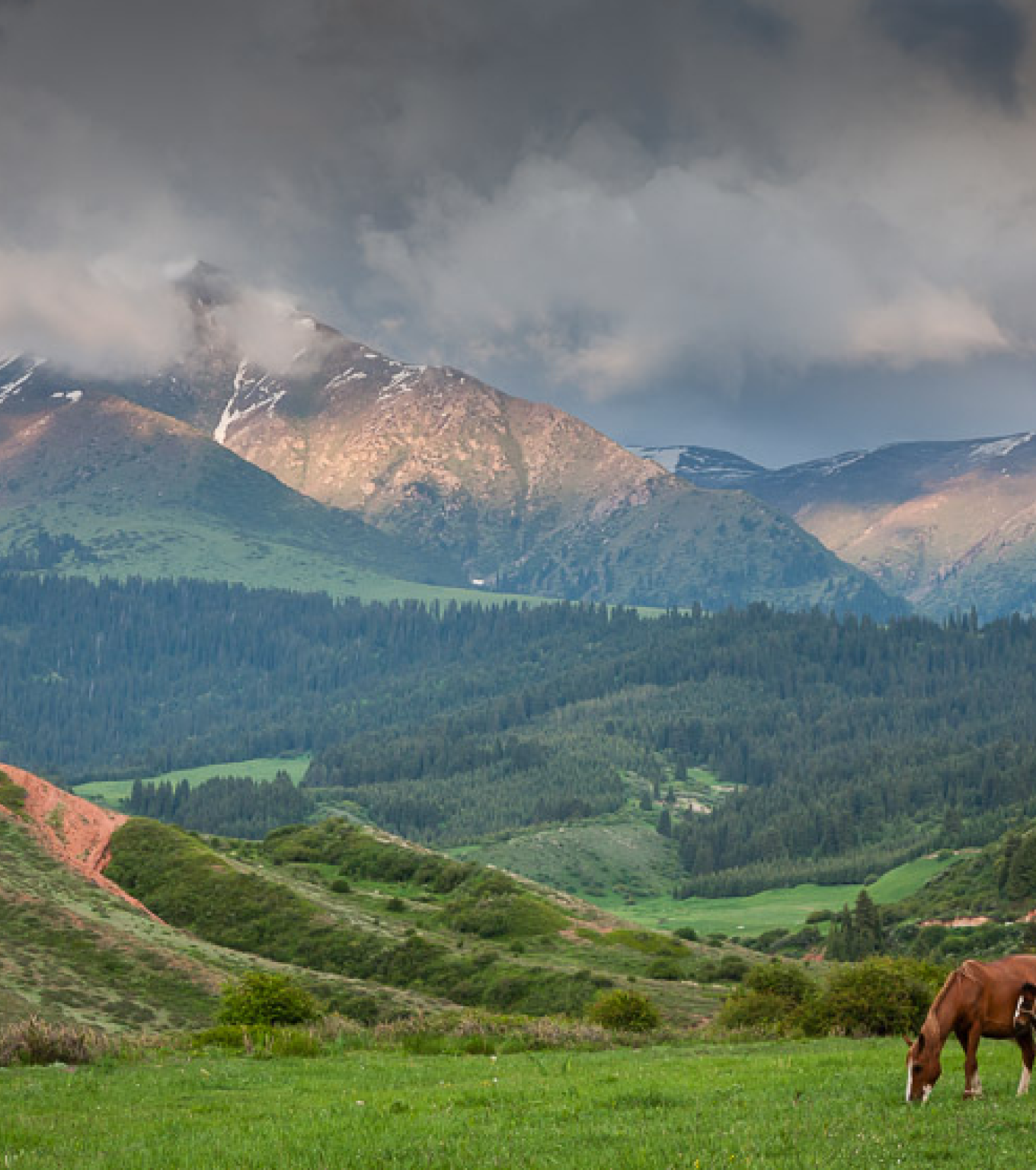
Protected Objects of Nature help to preserve the unique natural landscapes of Kyrgyzstan in their original form. In order to save wonderful natural landscapes, flora and fauna of the country there were created 6 reserves, 2 biosphere reserves protected by UNESCO and 75 national parks.
Ala-Archa gorge is one of the most famous sights of Kyrgyzstan. The Ala-Archa gorge is located in the Chuy Region, and is a national park. Every year, this alpine gorge receives hundreds of thousands of tourists, both local and foreign. There are several reasons for this popularity. Firstly, the Ala-Archa gorge is located only 30 kilometers from Bishkek and therefore it is very easy to get here and there is all the necessary tourist infrastructure: a good asphalt road, shops, hotels, cafes, and places to relax among beautiful nature. Secondly, the Ala-Archa gorge has its own geographical features - it is located on the central and highest part of the Kyrgyz ridge - the second longest Tien Shan ridge. Therefore, it is there where the mountains rise as high as possible above the plain, where numerous trails begin to the highest peaks of the Kyrgyz ridge. Ala-Archa is famous for its untouched nature: vast spruce forests, birch groves, numerous springs with clear glacial water and mighty cliffs.
Walnut and fruit forests of Arslanbob
Arslanbob Forest (also Arstanbap) is a large walnut forest located in the mountains of Ferghana and Chatkal ranges, in Jalal-Abad Region, at an altitude of 1700 meters. This is the largest walnut forest in the world and one of the most amazing places in Kyrgyzstan. Arslanbob forest is a natural forest that arose in ancient times. Scientists claim that his age may exceed 50 million years. The area of Arslanbob is 700,000 hectares, and numerous walnut, pistachio, almond, cherry plum, pear and many others grow on this vast territory. The total number of plants growing here exceeds 130. But anyway, the most noticeable part of the forest is walnut trees. The age of individual trees exceeds 1000 years, and each of them brings from 150 to 400 kilograms of nuts every year. In addition to the forest itself, the area around is very remarkable. The slopes of the Ferghana and Chatkal ranges in this place are composed of dolomite, and therefore are very different from other Tien Shan mountains in their unusual color and relief. The mighty white cliffs are adjacent to the endless green expanses of the Arslanbob forest, making this place absolutely unique. Such a large forest requires a large amount of water, and therefore this region is rich in numerous streams and rivers. There are also several waterfalls, the most notable of which are Big Arslanbob (80 meters) and Small Arslanbob (35 meters). Also on the territory of the reserve there are several lakes, one of which is sacred and called Kel-Mazar. Towering at this place, Babash-Ata peak, 4,436 meters high, is also considered sacred among the inhabitants of this place.
Sarychat-Ertash State Reserve is quite young from the reserves of Kyrgyzstan. This is a specially protected natural area, formed in 1995, which is located in Issyk-Kul region. It was organized by Decree of the Government of the Kyrgyz Republic and is included as a core zone in the Issyk-Kul Biosphere Territory, the status of the reserve in the World Network of Bioreserves (UNESCO 2002) in order to preserve unique natural complexes, rare and endangered species of animals and plants in Issyk-Kul region, as well as maintaining the overall ecological balance of the region. The territory of the reserve is located at the junction of Inner and Central Tien Shan in Sarychat-Ertash-Uchkul valley (a tributary of Sary-Jaz river) and is a site typical of a high-altitude zone. The total area of the reserve is 135,4 thousand ha, of which 72,080 thousand ha are allocated to the core zone, and 62,060 thousand ha to the buffer zone, located at altitudes from 2000 to 5000 meters above sea level.
Sary-Chelek Reserve is located in the western part of the Jalal-Abad Region, in the foothills of the Chatkal Range, at an altitude of 1940 meters. It includes a mountain called Sary-Chelek Lake, the largest in Western Tien-Shan and is the basis of the reserve and overall there are five lakes. The largest of the other lakes in this area are Iri-Kel and Kyla-Kel lakes, which are inferior in size to Sary-Chelek Lake, but not at all inferior in beauty. Due to the depth not as deep as in Sary-Chelek itself, at the bottom of these small lakes you can clearly see trunks of fallen trees and see flocks of frightened fish. The territory of Sary-Chelek biosphere reserve begins on the southern shore of the lake, which was created to preserve the unique natural diversity of this area. Within the reserve there is a large forest land consisting of walnut and fruit trees. Around Sary-Chelek Reserve there are winding hiking trails for trekking and horseback riding pass, leading to the shores of five Sary-Chelek lakes through small but rather steep passes. The tourist base of the lake is the village of Arkyt, located a few kilometers below the lake Sary-Chelek. Also on Sary-Chelek Lake you can ride a motor boat to see the far part of the lake, which is almost invisible from the shore.
Chon-Kemin National Park is an environmental, research institution, and belongs to the category of specially protected natural areas of the Kyrgyz Republic. It was formed in 1997 in order to preserve natural complexes, forests, fauna and flora, which have special environmental, aesthetic value, due to the favorable combination of natural and cultural landscapes, and for use in recreational, educational, scientific and as cultural center. The climate of the region is sharply continental with great diversity depending on the height above sea level, exposure and slope steepness. At equal heights, the northern slopes are colder and wetter, the southern slopes are warmer and drier. In the zone where the settlements of the valley are located, the average temperature in January is –10.5 °C, and in July –17.0 °C. In the reserve Chon-Kemin River flows from north-east to south-west between western halves of these ranges. Its length is about 120 km. Chon-Kemin Reserve also has two small alpine lakes. The moraine-dammed Dzhashyl-Kol (Chelek) Lake is located at an altitude from 3150 to 3427 meters above sea level. Köl-Tör (Kel-Kogur Lake) is located at an altitude from 2420 to 2465 meters above sea level on the northern slope of the Kungei-Ala-Too ridge. The area of the lake is about 16 hectares.

